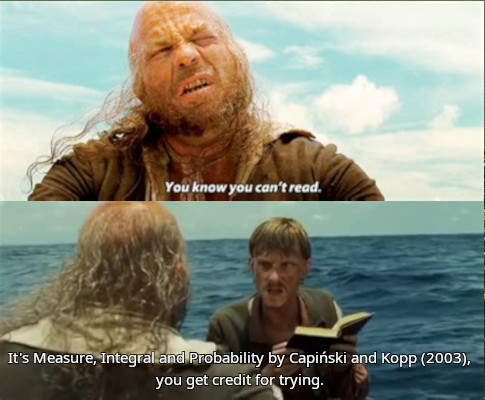I was told to share this motivational meme I made today.
#measuretheory
`Kakutani's theorem is a fundamental result on the equivalence or mutual singularity of countable product measures. It gives an "if and only if" characterisation of when two such measures are equivalent, and hence it is extremely useful when trying to establish change-of-measure formulae for measures on function spaces.`
https://en.wikipedia.org/wiki/Kakutani's_theorem_(measure_theory)
Question 1. was solved here [1]. The answer isn't perfect but it's better than nothing.
I don't know if the function in the answer to this post [1] has a finite expected value using section 3.2 and 6.1 of this paper [2].
#Answer #PathalogicalFunctions #EverywhereSurjectiveFunctions #Mean #ExpectedValue #MeasureTheory #HausdorffMeasure #HausdorffDimension
Suppose \(A\subseteq\mathbb{R}^{2}\) is Borel and \(B\) is a rectangle of \(\mathbb{R}^2\). In addition, suppose the Lebesgue measure on the Borel \(\sigma\)-algebra is \(\lambda(\cdot)\):
Question: How do we define an explicit \(A\), such that:
1. \(\lambda(A\cap B)>0\) for all \(B\)
2. \(\lambda(A\cap B)\neq\lambda(B)\) for all \(B\)?
For a potential answer, see this reddit post [1]. (It seems the answer is correct; however, I wonder if there's a simpler version that is less annoying to prove.)
Moreover, we meaningfully average \(A\) with the following approach:
Approach: We want an unique, satisfying extension of the expected value of \(A\), w.r.t the Hausdorff measure in its dimension, on bounded sets to \(A\), which takes finite values only
Question 2: How do we define "satisfying" in this approach?
(Optional: See section 3.2, & 6 of this paper [2].)
#UnboundedSets #Sets #LebesgueMeasure #MeasureTheory #Measure #ExpectedValue #Expectancy #Mean #Integration #HausdorffMeasure #HausdorffDimension
Suppose \(f:\mathbb{R}\to\mathbb{R}\) is Borel. Let \(\text{dim}_{\text{H}}(\cdot)\) be the Hausdorff dimension and \(\mathcal{H}^{\text{dim}_{\text{H}}(\cdot)}(\cdot)\) be the Hausdorff measure in its dimension on the Borel \(\sigma\)-algebra.
Question: If \(G\) is the graph of \(f\), is there an explicit \(f\) such that:
1. The function \(f\) is everywhere surjective (i.e., \(f[(a,b)]=\mathbb{R}\) for all non-empty open interval \((a,b)\))
2. \(\mathcal{H}^{\text{dim}_{\text{H}}(G)}(G)=0\)
If such \(f\) exists, we denote this special case of \(f\) as \(F\).
Note, not all everywhere surjective \(f\) satisfy criteria 2. of the question. For example, consider the Conway base-13 function [1]. Since it's zero almost everywhere, \(\text{dim}_{\text{H}}(G)=1\), and \(\mathcal{H}^{\text{dim}_{\text{H}}(G)}(G)=+\infty\).
Question 2: For any real \(\mathbf{A},\mathbf{B}\) is the expected value of \(\left.f\right|_{[\mathbf{A},\mathbf{B}]}\), w.r.t the Hausdorff measure in its dimension, defined and finite?
If not, see this paper [2] for a partial solution.
Optional: Is there other interesting properties of \(F\)?
[1]: https://en.wikipedia.org/wiki/Conway_base_13_function
#PathalogicalFunctions #EverywhereSurjectiveFunctions #Mean #ExpectedValue #MeasureTheory #Measure #HausdorffMeasure #HausdorffDimension
Every irrational number has a unique infinite continued fraction expansion.
Consider the subset whose continued fraction coefficients has an infinite subsequence with each term dividing the next.
This is an explicit non-Borel measurable set, described by Lusin in 1927
New almostsure blog post: Non-measurable sets
youtube.com/@xenaproject
for #mathematics #mathsbasics#mathematicallogic #sets #logic #topology #numbertheory #linearalgebra
#probability #measuretheory
#functionalanalysis
A third (!) amazing thing I’ve learned today!
(This one’s a bit less accessible than the other two, as it requires some mathematical knowledge)
There is, it seems, a strictly monotone polynomial-valued measure for subsets of R^n
Video: https://youtube.com/watch?v=h_CFMtRQiek
Preprint: https://arxiv.org/abs/2008.09969
I'm looking for work! My current funding runs out soon, so I'm looking for what's next. More contract work? Full-time employment? Something else?
Most of my work has been in #julialang, developing #foss packages for probabilistic programming (#probprog) and #measuretheory. More generally, I'm interested in #bayesian #stats, performance algorithms, composability, and #functionalprogramming. I love learning and #mentoring, and I've been a team lead and IC, enjoying both.
Please retoot!
By harder definition he => 8 sums/ definition
He doesn't rely on zfc #measuretheory to rigorously define continuity, but related connects sets with continuity. So this book seem to be more about #manifold and less about #calculus
Compact sets are challenging, at least here.
One approach #measuretheory : start with a Radon measure, defined as a positive linear functional on Cc(X) #Bourbaki assumimg X starts as a topological space, not a set. For locally compact spaces an integration theory is then recovered.
One approach #measuretheory : start with a Radon measure, defined as a positive linear functional on Cc(X) #Bourbaki assumimg X starts as a topological space, not a set. For locally compact spaces an integration theory is then recovered.

